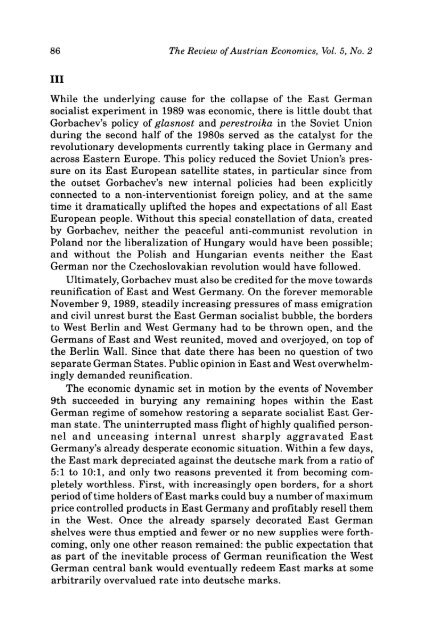Review of Austrian Economics - The Ludwig von Mises Institute
Review of Austrian Economics - The Ludwig von Mises Institute
Review of Austrian Economics - The Ludwig von Mises Institute
You also want an ePaper? Increase the reach of your titles
YUMPU automatically turns print PDFs into web optimized ePapers that Google loves.
86 <strong>The</strong> <strong>Review</strong> <strong>of</strong> <strong>Austrian</strong> <strong>Economics</strong>, Vol. 5, No. 2<br />
III<br />
While the underlying cause for the collapse <strong>of</strong> the East German<br />
socialist experiment in 1989 was economic, there is little doubt that<br />
Gorbachev's policy <strong>of</strong> glasnost and perestroika in the Soviet Union<br />
during the second half <strong>of</strong> the 1980s served as the catalyst for the<br />
revolutionary developments currently taking place in Germany and<br />
across Eastern Europe. This policy reduced the Soviet Union's pressure<br />
on its East European satellite states, in particular since from<br />
the outset Gorbachev's new internal policies had been explicitly<br />
connected to a non-interventionist foreign policy, and at the same<br />
time it dramatically uplifted the hopes and expectations <strong>of</strong> all East<br />
European people. Without this special constellation <strong>of</strong> data, created<br />
by Gorbachev, neither the peaceful anti-communist revolution in<br />
Poland nor the liberalization <strong>of</strong> Hungary would have been possible;<br />
and without the Polish and Hungarian events neither the East<br />
German nor the Czechoslovakian revolution would have followed.<br />
Ultimately, Gorbachev must also be credited for the move towards<br />
reunification <strong>of</strong> East and West Germany. On the forever memorable<br />
November 9, 1989, steadily increasing pressures <strong>of</strong> mass emigration<br />
and civil unrest burst the East German socialist bubble, the borders<br />
to West Berlin and West Germany had to be thrown open, and the<br />
Germans <strong>of</strong> East and West reunited, moved and overjoyed, on top <strong>of</strong><br />
the Berlin Wall. Since that date there has been no question <strong>of</strong> two<br />
separate German States. Public opinion in East and West overwhelmingly<br />
demanded reunification.<br />
<strong>The</strong> economic dynamic set in motion by the events <strong>of</strong> November<br />
9th succeeded in burying any remaining hopes within the East<br />
German regime <strong>of</strong> somehow restoring a separate socialist East German<br />
state. <strong>The</strong> uninterrupted mass flight <strong>of</strong> highly qualified personnel<br />
and unceasing internal unrest sharply aggravated East<br />
Germany's already desperate economic situation. Within a few days,<br />
the East mark depreciated against the deutsche mark from a ratio <strong>of</strong><br />
5:1 to 10:1, and only two reasons prevented it from becoming completely<br />
worthless. First, with increasingly open borders, for a short<br />
period <strong>of</strong> time holders <strong>of</strong> East marks could buy a number <strong>of</strong> maximum<br />
price controlled products in East Germany and pr<strong>of</strong>itably resell them<br />
in the West. Once the already sparsely decorated East German<br />
shelves were thus emptied and fewer or no new supplies were forthcoming,<br />
only one other reason remained: the public expectation that<br />
as part <strong>of</strong> the inevitable process <strong>of</strong> German reunification the West<br />
German central bank would eventually redeem East marks at some<br />
arbitrarily overvalued rate into deutsche marks.

















